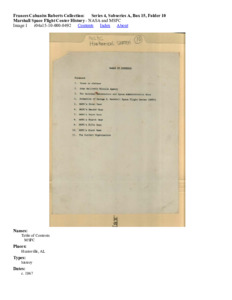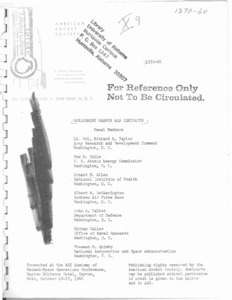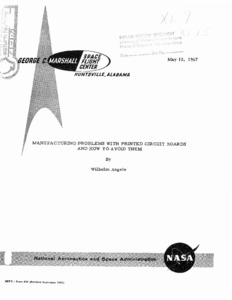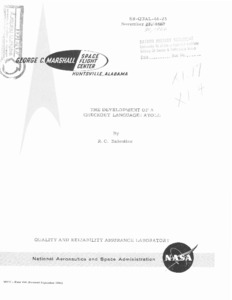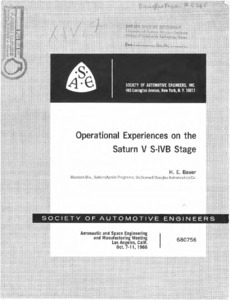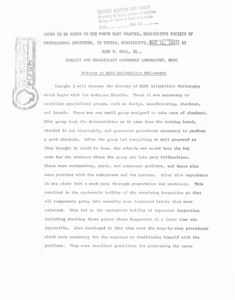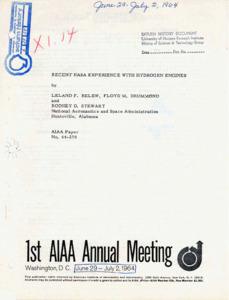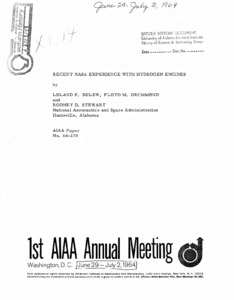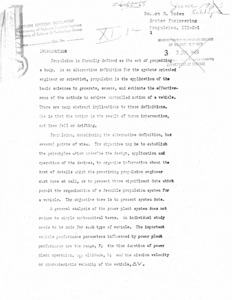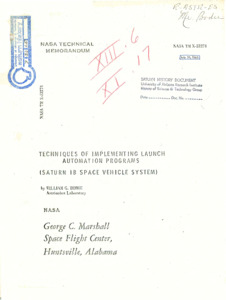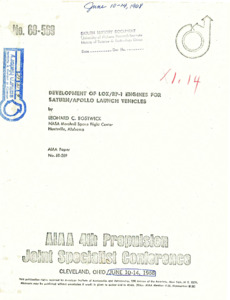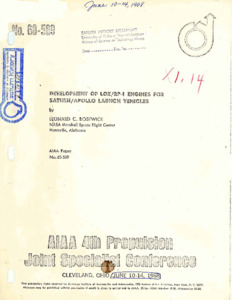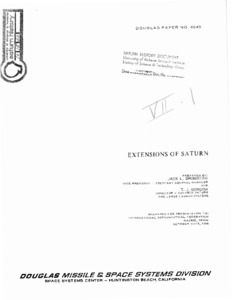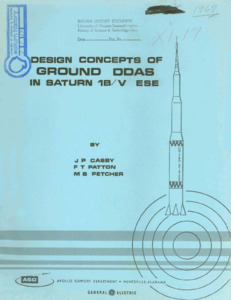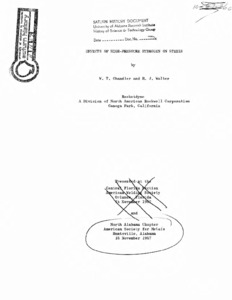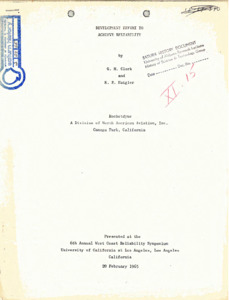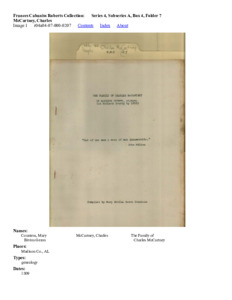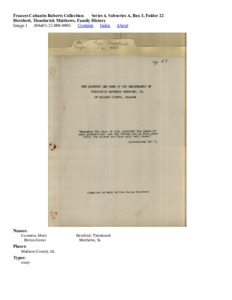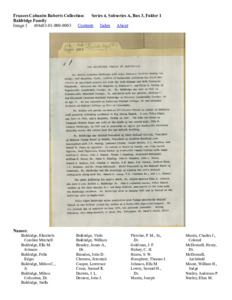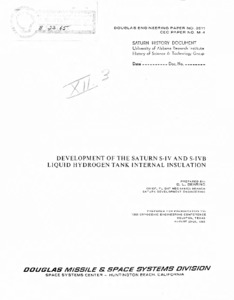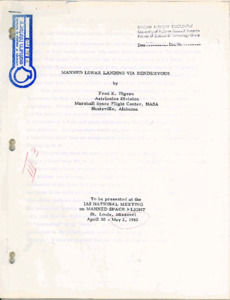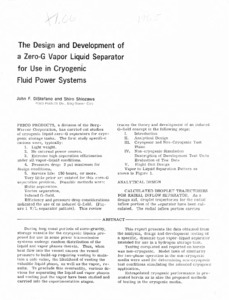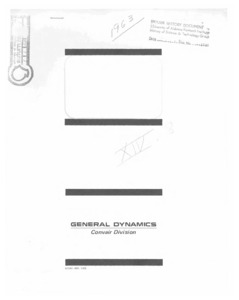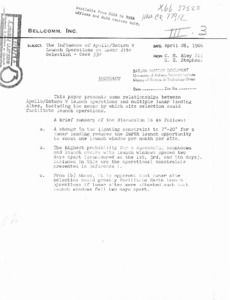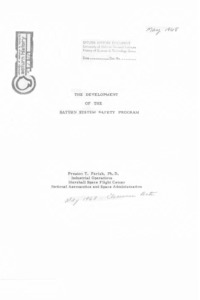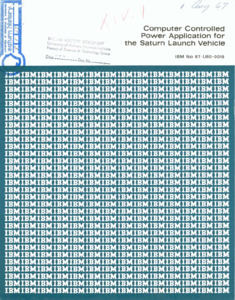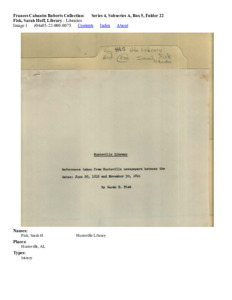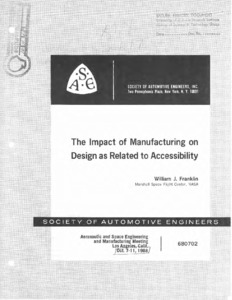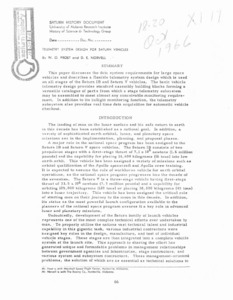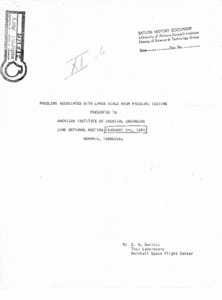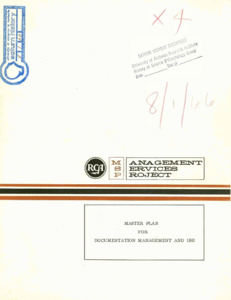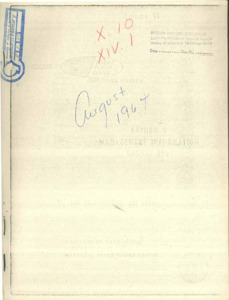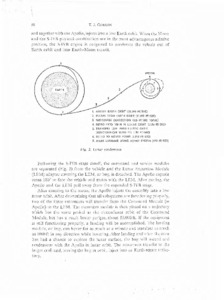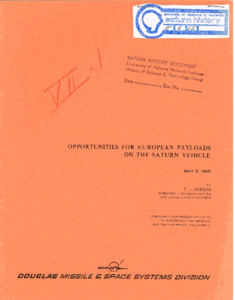
Browse Items (165 total)
Sort by:
-
Marshall Space Flight Center History
NASA and MSFC -
"Government Grants & Contracts."
The Army medical contract, grant, and research interest in the bio-science area. -
"Instrumentation Programming for Computer Controlled Digital Data Processing."
A number of considerations are necessary in instrumentation programming, many of which are either not applicable or applicable to a lesser degree in other types of programming. This paper discusses these problems in general terms and illustrates how they have been dealt with specifically. The latter is done by describing the programming and operation of a data reduction system. -
"Manufacturing problems with printed circuit boards and how to avoid them."
To be presented at the NASA / Rocketdyne Manufacturing Technology Review. Focuses on how best to avoid printed circuit boards. -
"The development of a checkout language : ATOLL."
ATOLL was developed to fulfill the requirements for a common computer language that could be used by the test engineers for launch and factory checkout. "ATOLL" is the abbreviated name for Acceptance, Test, Or Launch Language. -
"Operational Experiences on the Saturn V S-IVB stage."
This paper presents a light, but reverent, discussion of some of the Douglas operational experiences on the Saturn V/S-IVB stage. Certain relevant aspects of earlier work on the Thor intermediate range ballistic missile, the Saturn I S-IV stage, and the Uprated Saturn I S-IVB stage are also discussed.; Aeronautic and Space Engineering and Manufacturing Meeting, Los Angeles, Calif., Oct. 7 - 11, 1968. -
"History of MSFC Reliability Philosophy."
Paper given to North East Chapter , Mississippi Society of Professional Engineers. Essay discussing the history of the MSFC Reliability Philosophy. -
"Recent NASA experience with hydrogen engines."
This paper presents a review of the experience which has accumulated in the development of the Liquid Hydrogen J-2 and RL10 rocket engines. These engines are being developed by the Rocketdyne Division of North American Aviation and Pratt & Whitney Aircraft, a Division of United Aircraft Corporation respectively.; On NASA Technical Reports Server (NTRS) as Unclassified; No Copyright; Unlimited; Publicly available. Also found on AIAA site. -
"Recent NASA experience with hydrogen engines."
This paper presents a review of the experience which has accumulated in the development of the Liquid Hydrogen J-2 and RL10 rocket engines. These engines are being developed by the Rocketdyne Division of North American Aviation and Pratt & Whitney Aircraft, a Division of United Aircraft Corporation respectively.; On NASA Technical Reports Server (NTRS) as Unclassified; No Copyright; Unlimited; Publicly available. Also found on AIAA site. -
"System engineering propulsion, III-C-1."
Page numbering is inconsistent; there are no pages numbered 14 - 17. Some pages have handwritten numbers, others have no numbers at all.; The print quality of many pages is poor. Discusses the definition and function of propulsion as well as how to most effectively employ it . -
"Techniques of implementing launch automation programs" (Saturn IB space vehicle system).
This paper identifies the methods and equipment through which automation is becoming a major factor in testing and launching Saturn IB space vehicles. The merits of a digital guidance computer and its impact in extending automated checkout are stressed; also a logical basis is established for computer and manual test control. Hardware and software elements of the automated system are described, and details pertaining to reliability are emphasized. A concluding appraisal suggests that automation will play an expanding role in future test and launch operations. -
"Development of LOX/RP-1 Engines for Saturn/Apollo Launch Vehicles."
The development of liquid rocket engines follow similar patterns regardless of engine size. During the development of the H-1 and F-1 engines, many problems were encountered. Methods of solving the combustion instability problem are discussed. A description is given of the major components of each engine, outlining their unique features. The requirements for an insulation cocoon are discussed. Problems associated with materials substitution are provided; also highlighted is the fact that problems occur after engine deliveries and require continued development support. Safety features incorporated on the engines are mentioned. Solution to problems encountered in flight are discussed. Upratings of both engines systems are presented graphically.; On the NASA Technical Reports Server (NTRS) unclassified. Can also be found on AIAA. -
Development of LOX/RP-1 engines for Saturn/Apollo launch vehicles.
The development of liquid rocket engines follow similar patterns regardless of engine size. During the development of the H-1 and F-1 engines, may problems were encountered. Mehtods of solving the combustion instability problem are discussed.; AIAA 4th Propulsion Joint Specialist Conference, Cleveland, Ohio, June 10-14, 1968.; Also available on NASA Technical Reports Server (NTRS) as unclassified. Can be ordered. Also on AIAA. -
"Extensions of Saturn."
This paper discusses the possible applications of Saturn vehicles to future space exploration. Potential missions utilizing Apollo derived hardware are examined. Research, development, and operations in earth orbit as well as lunar exploration, unmanned and manned interplanetary exploration are reviewed. These hypothetical missions are discussed in the context of the present and potential capability of three configurations of the Saturn vehicle; an uprated Saturn I, a three-stage Saturn V and a four-stage Saturn V. NOTE: Work presented herein was conducted by the Douglas Missiles and Space Systems Division under company-sponsored research and development funds. Therefore, the concepts and objectives described within this paper reflect the opinions of the authors and do not necessarily constitute endorsement by NASA, the Air Force, or any other U.S. Government organization. The nominal performance numbers presented are typical of the current configurations and possible future vehicle configurations. -
"Development of LOX-Hydrogen Engines for the Saturn Apollo Launch Vehicles."
During the development of the RL-10 and J-2 engines, many problems were encountered. Solutions to the significant problems are contained. A description of these LOX-Hydrogen engines, outlining the unique features of each will be given. Performance parameters for both engine systems are tabulated. Specific applications to various stages are shown. -
"Design Concepts of Ground DDAS in Saturn 1B/V ESE."
In the Saturn IB/V programs the sheer quantity of data required for computer processing and ESE display makes it necessary to provide an efficient data acquisition system. For much of the data originating in the launcher this requirement is satisfied by the Ground Digital Data Acquisition System (DDAS). This paper provides a technical description of the Ground DDAS with emphasis placed on the unique design concepts of this telemetry system. -
"Propulsion : the key to space travel."
Cover has: P. D. Castenholz and H. K. Griggs, Advanced Systems, Advanced Projects Department. D. W. Hege, Manager, Advanced Projects. Paper regarding the importance of propulsion technology and the future missions that would require advancements in that field. -
"Effects of High-Pressure Hydrogen on Steels."
Hydrogen embrittlement of steels is hardly a new subject, but the effects of high-pressure hydrogen have been treated in detail only more recently and to a much more limited extent. Thus, most investigations of hydrogen embrittlement have been concerned with hydrogen in metals, while for the high-pressure hydrogen problem, we are more concerned with metals in(in contact with) hydrogen. I believe there is a difference and, certainly,different mechanisms of embrittlement are at least possible.; Presented at the Central Florid Section, American Welding Society, Orlando, Florida, 14 November 1967 and North Alabama Chapter, American Society for Metals, Huntsville, Alabama, 16 November 1967. -
"Development Effort to Achieve Reliability."
Presented at the 6th West Coast Reliability Symposium, University of California at Los Angeles, Los Angeles, California, 20 February 1965.The development of a large liquid rocket engine can represent the expenditure of several hundred million dollars of effort. Before 30 percent of the contracted development funds have been expended, however, the engine will probably have operated for the mission duration. The capability to operate at least one successful test early in a development program is evidence of achieving a minimal reliability level, but the major objective of the development program is producing a design which performs reliably. A rocket engine reliability prediction must view reliability as a dynamic concept, constantly being altered by development effort. -
Yeatman, Preston
Families -
"Saturn IB inflight photographic instrumentation system."
This Internal Note presents the development of the Saturn inflight photographic instrumentation program from its original development requirement concept to the flight hardware application on Saturn vehicles. A comprehensive description of the infight photographic instrumentation system is given along with data concerning testing, operation, application, and evaluation of the system after recovery. This Internal Note shows that the system has been successfully developed,that valuable information has been obtained from film retrieved from recovered capsules, and that the system can be used with a high degree of reliability. -
"Development of the Saturn S-IV and S-IVB Liquid Hydrogen Tank Internal Insulation."
In April of 1960 the Douglas Aircraft Company was awarded a contract to develop the second and uppermost stage for the Saturn I space booster. In order to realize the high specific impulse available, this stage, called the S-IV, was to utilize liquid hydrogen and liquid oxygen as the propellants. After burn-out of the first stage, the S-IV Stage was to ignite its engines at an altitude of approximately 200,000 feet, burn for approximately 8 minutes, and inject a 20,000 lb spacecraft into a low earth orbit. This program represented Douglas's first major endeavor with liquid hydrogen. It was necessary to develop an insulation for the S-IV Stage that was capable of withstanding the thermal shock associated with loading, could provide adequate insulative properties to limit the flow of heat into the hydrogen, and was of minimum weight. This latter fact cannot be over emphasized because every extra pound of insulation is one less pound of available payload weight. -
"Manned Lunar Landing via Rendezvous."
Paper to be presented at the IAS National Meeting on Manned Space Flight. Focuses on operations leading to injection of the space craft into the lunar transfer trajectory. -
"Design and Development of a Zero-G Vapor Liquid Separator For Use in Cryogenic Fluid Power Systems."
During long coast periods of zero-gravity, storage vessels for the cryogenic liquids proposed for use in some power transmission systems undergo random distribution of the liquid and vapor phases therein. Thus, when heat flow into the vessel causes the vessel pressure to build-up requiring venting to maintain a safe value, the likelihood of venting the valuable liquid phase, as well as the vapor, results. To preclude this eventuality, various devices for separating the liquid and vapor phases and venting just the vapor have been studied and carried into the experimentation stages. -
"NEXUS concept of a large reusable earth launch vehicle."
Aspects of Earth-to-orbit delivery are discussed and a cost analysis of the logistic operation and the cost of orbital operations are presented. Probabilities of success of orbital delivery and the operational and economic aspects of establishing large orbital installations and maintaining a large transportation volume in the 1975/85 time period are compared for the two cases using a large number of Saturn V versus a smaller number of 1-stage chemical Post-Saturn launch vehicles. Performance parameters of chemical, chemonuclear and nuclear launch vehicles are compared. The concept of a blunt launch vehicle configuration referred to as NEXUS is presented in detail. Applications of this configuration to chemonuclear propulsion and to a 50 ft diameter version of Saturn V with recoverable first stage are discussed. -
"The Influence of Apollo/Saturn V Launch Operations on Lunar Site Selection: Case 330."
This paper presents some relationships between Apollo/Saturn V launch operations and multiple lunar landing sites, including the means by which site selection could facilitate launch operations. -
"The development of the Saturn system safety program."
This paper describes the major highlights or milestones passed in the development of a System Safety Program at MSFC since early 1967. it discusses accomplishments, problems resolved, and decisions made for Apollo Saturn vehicles AS-501 and AS-502, and projects that are to be accomplished on future Saturn vehicles. -
"Computer Controlled Power Application for the Saturn Launch Vehicle".
This paper describes a real-time digital computer program that controls the application of electrical power to the S-IVB stage of the Saturn vehicle at Cape Kennedy, Florida. Douglas Aircraft Company, the S-IVB stage manufacturer, provided NASA with the program requirements relative to the energizing sequence, voltage and current measurement tolerances, and vehicle system operational tests. International Business Machines Corporation provided NASA with the computer program to satisfy the task requirements. The program conjoined the components of the Electrical Support Equipment (two RCA 110A computers and control and instrumentation devices) into a closed loop system. The supporting operating system program by IBM is described. -
Fisk, Sarah Huff, Library
Libraries -
"The impact of manufacturing on design as related to accessibility."
The purpose of this paper is to emphasize the need for accessibility in the assembly and maintenance of spacecraft. This is especially pertinent because accessibility to subsystems for replacement, repair, and maintenance has proven to be one of the more costly phases of preflight preparation. The most successful programs in this day and age have been when the design and manufacturing engineers work side by side around a mockup where solutions to the problems can be visually seen and solved, keeping in mind the assembly as related to accessibility. Therefore, it will be shown that in order to overcome the difficulties, designers should adapt a hard, fast ground rule that each unit must be accessible and individually removable without disturbing the other units.; Aeronautic and Space Engineering and Manufacturing Meeting, Los Angeles, Calif. Oct. 7 - 11, 1968. -
"Telemetry system design for Saturn vehicles."
This paper discusses the data system requirements for large space vehicles and describes a flexible telemetry system design which is used on all stages of the Saturn IB and Saturn V vehicles. The basic vehicle telemetry design provides standard assembly building blocks forming a versatile catalogue of parts from which a stage telemetry subsystem may be assembled to meet almost any conceivable monitoring requirement. In addition to its inflight monitoring function, the telemetry subsystem also provides real time data acquisition for automatic vehicle checkout. -
"Problems associated with large scale high pressure testing."
Paper detailing the problems identfified in high pressure testing. -
"Master plan for documentation management and use."
Prepared for National Aeronautics and Space Administration, George C. Marshall Space Flight Center, Huntsville, Alabama. Accepted by V.C. Sorensen, Chief, Management Services Office. Management Services Project, RCA; SUMMARY: The objective of this study is to describe a comprehensive plan for the development and full utilization of methods and means to be employed in the years prior to 1976 for the effective acquisition, collection, storage, retrieval, distribution, and use of engineering documentation. Because of the violently changing state of the art of data acquisition, storage, and retrieval the description of the plan does not embrace the details of a total decade of phased change. Rather it describes actions that can and should be taken in the relatively near future, and proposes a continuing series of later studies to keep this plan current for the full decade. -
Saturn V management information : August 1964 : Volume VI.
This document contains copies of management charts maintained in the Managerial Data Center of the executive Staff on the Saturn V project. To facilitate use of this document, all Saturn V classified data has been removed and will be published in Volume XI. A list of these charts are shown on the "Table of Contents". Information on other MSFC activities will be published in separate volumes as indicated on the "Schedule for Publication of Data Bank Charts" contained in this volume. -
"Engineering Safety Into Missile-Space Systems."
Safety Engineering, as applied to complex missile and space systems, has developed a new methodology referred to as "System Safety Engineering." The requirement for a comprehensive approach to safety which is included as a contractually covered adjunct to the design, development, and operational phases of a systems life cycle has become apparent from costly missile mishap experience. The general concepts and accomplishments of this new engineering discipline are described along with possible beneficial relationships with Reliability and other recognized organizational elements engaged in safety related activities. -
"A survey of propulsion problems as related to space vehicle design."
Incomplete document. Displays errors in space-vehicle design as they relate to space travel. -
"Opportunities for European Payloads on the Saturn Vehicle."
Prepared for presentation to the Eurospace Conference. In this paper, we will not deal with the first two questions, which must be of interest to every potential experimenter, but only with the last question of vehicle availability.
